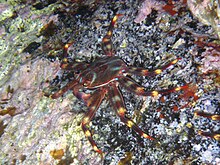Percnon gibbesi is a species of crab.[1][3] It is one of at least two species commonly called Sally Lightfoot (the other being the semi-terrestrial Grapsus grapsus from the Pacific coast of the Americas), and is also referred to as the nimble spray crab[2] or urchin crab.[4] It has been described as "the most invasive decapod species to enter the Mediterranean".[3]
| Percnon gibbesi | |
|---|---|

| |
| Scientific classification | |
| Domain: | Eukaryota |
| Kingdom: | Animalia |
| Phylum: | Arthropoda |
| Class: | Malacostraca |
| Order: | Decapoda |
| Suborder: | Pleocyemata |
| Infraorder: | Brachyura |
| Family: | Percnidae |
| Genus: | Percnon |
| Species: | P. gibbesi
|
| Binomial name | |
| Percnon gibbesi | |
| Synonyms | |
| |
Description
editAdults have a carapace 30 millimetres (1.2 in) wide, and legs with yellow rings at the joints.[5] Each of the five pairs of walking legs has a row of spines along the leading edge.[5] Females carrying eggs have been caught off West Africa between February and April and August; the larvae which hatch from them are planktonic and long-lived, which may contribute to the species' invasiveness.[5]
Taxonomy
editThe genus Percnon is currently placed in the family Percnidae,[1] although it has also been placed in Plagusiidae.[2][6]
Distribution
editP. gibbesi is one of the most widespread grapsid crabs, being found on both sides of the Atlantic Ocean and on the Pacific coast of North America. There, its range extends from California to Chile, while in the Atlantic, it occurs natively from Florida to Brazil and from Madeira to the Gulf of Guinea.[5] It has recently invaded the Mediterranean Sea, having first been discovered at Linosa, Sicily in 1999.[7] It has subsequently been found on the Balearic Islands, in Greece, in Libya in Malta and in Israel.[8]
Ecology
editUnusually among temperate crabs, P. gibbesi is strictly herbivorous.[9] In the Caribbean Sea, P. gibbesi is associated with the sea urchin Diadema antillarum.[10] In the Mediterranean Sea, P. gibbesi lives almost exclusively among boulders, and is out-competed by the native species Pachygrapsus marmoratus.[11] P. gibbesi is preyed upon by fish and invertebrates.[5]
References
edit- ^ a b c "Percnon gibbesi (H. Milne Edwards, 1853)". WoRMS. World Register of Marine Species. 2023. Retrieved 27 March 2023.
- ^ a b c "Percnon gibbesi (H. Milne Edwards, 1853)". Integrated Taxonomic Information System. Retrieved 27 March 2023.
- ^ a b S. Cannicci; L. Garcia & B. S. Galil (2006). "Racing across the Mediterranean — first record of Percnon gibbesi (Crustacea: Decapoda: Grapsidae) in Greece" (PDF). JMBA2 Biodiversity Records. Archived from the original (PDF) on 2011-07-21.
- ^ Florent Charpin. "Percnon gibbesi". Florent's Guide To The Tropical Reefs. Retrieved January 9, 2010.
- ^ a b c d e B. S. Galil (November 6, 2006). "Percnon gibbesi". Delivering Alien Invasive Species Inventories for Europe. Archived from the original on October 17, 2012. Retrieved January 9, 2010.
- ^ Ng, Peter K. L.; Danièle Guinot & Peter J. F. Davie (2008). "Systema Brachyurorum: Part I. An annotated checklist of extant Brachyuran crabs of the world" (PDF). Raffles Bulletin of Zoology. 17: 1–286.
- ^ Marco Relini; Lidia Orsi; Valentina Puccio; Ernesto Azzurro (2000). "The exotic crab Percnon gibbesi (H. Milne Edwards, 1853) (Decapoda, Grapsidae) in the Central Mediterranean". Scientia Marina. 64 (3): 337–340. doi:10.3989/scimar.2000.64n3337.
- ^ Housameddin M. Elkrwe; Hasan M. Elhawaj; Bella S. Galil; Abdallah ben Abdallah (2008). "The first record of Percnon gibbesi (H. Milne Edwards, 1853) (Crustacea: Decapoda: Plagusiidae) from the southern rim of the Mediterranean" (PDF). Aquatic Invasions. 3 (2): 243–245. doi:10.3391/ai.2008.3.2.16. Archived from the original (PDF) on 2011-07-21.
- ^ V. Puccio; M. Relini; E. Azzurro; L. Orsi Relini (2006). "Feeding habits of Percnon gibbesi (H. Milne Edwards, 1853) in the Sicily Strait". Hydrobiologia. 557 (1): 79–84. doi:10.1007/s10750-005-1310-2. S2CID 5970848.
- ^ Rickey Wallace (2007). "Frequency of Percnon gibbesi in relation to Diadema antillarum at Rodney's Rock" (PDF). Texas A&M University.
- ^ Marija Sciberras & Patrick J. Schembri (2008). "Biology and interspecific interactions of the alien crab Percnon gibbesi in the Maltese Islands". Marine Biology Research. 4 (5): 321–332. doi:10.1080/17451000801964923.
External links
edit- Media related to Percnon gibbesi at Wikimedia Commons
- Photos of Percnon gibbesi on Sealife Collection